

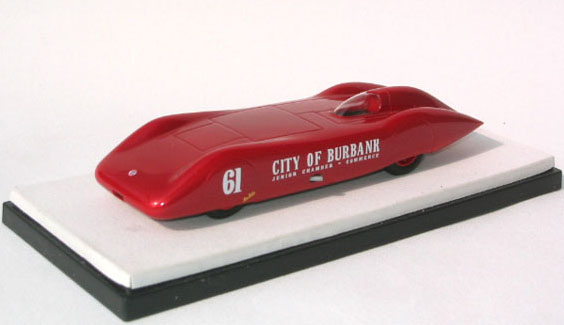
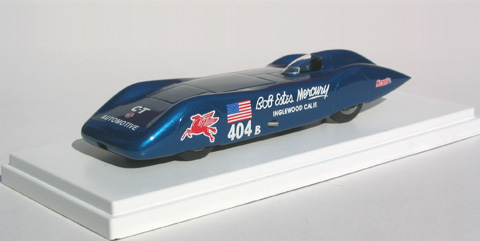
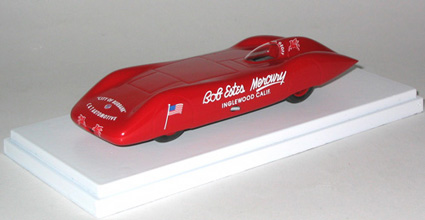
Go to the Hill-Davis model page |
|---|
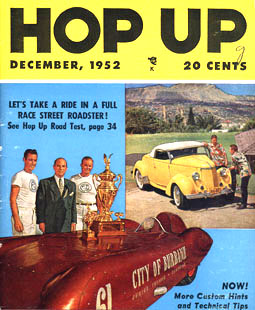
No matter by which name you know it, or you prefer to call it, the "City of Burbank", the "Bob Estes Mercury", the "Hill-Davis" or the "C&T" streamliner, the car built and raced in the early fifties by George Hill and Bill Davis played an all important role in the process of upgrading the hot-rodding movement from "nuts" status to full recognisement by the automobile world as an adult form of motor racing. It was in fact the first car built by young Southern California hot-rodders to capture International, FIA sanctioned land speed records. And truly significant records indeed, as they formerly belonged to no less than Bernd Rosemeyer's Auto Union, who had set them in 1937.
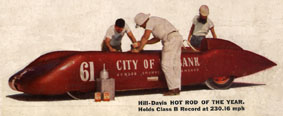
The car, initially known as the "City of Burbank" because of the sponsorship by the local Junior Chamber of Commerce, was built by Bill Davis and George Hill (later to be well known as a writer and magazine editor), but a key role in the design of the chassis and particularly of the body shape was played by Dean Batchelor, streamlining pioneer and one of the leading personalities in the hot rodding movement, later to become the most respected of its commentators and historians.
This was Batchelor's (and his partner John F. Morris') second experience in land speed design, as he had been partner with Alex Xidias in the So-Cal streamliner. Batchelor and Morris designed the Hill-Davis car at the same time as another extremely successful car, the Shadoff Spl., which would appear a year later and, not surprisingly, looked pretty much like a rear-engined version of the Hill-Davis car.(A model of the Shadoff Spl. is available in this same range)
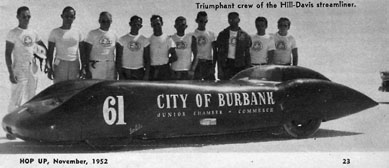
Neither George Hill nor Bill Davis had much experience in chassis building, as they both had raced just roadsters so far, and of course money was extremely limited, so everything was kept as simple as possible: chrome-moly tubes of 3 ins diameter were used, as well as everything that could be cannibalized from their two roadsters: Halibrand quick-change rear end, transmission, etc. The body was hand-formed from fiberglass and as to the engine, the two were lucky to receive a 320HP Mercury OHV on loan from Don Clark and Clem TeBow of C.T. Automotive (spelt C&T or CT or C-T on the car).
With the car just finished the night before, Hill and Davis showed up at Speed Week 1952 and after the usual trial and error process Hill, who took care of the driving, finally managed to set an outstanding SCTA Class B record at 230.16 mph; then they tried their luck in the smaller A class (classes were arranged in quite a different way at the time), but the engine did not stand the return run (it was the same engine, but running on just six cylinders).

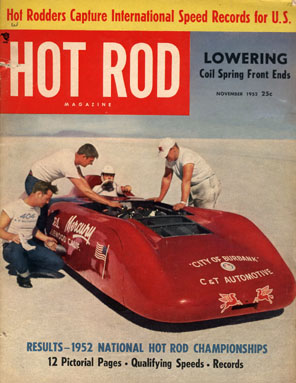
The two partners had not realized it at first, but the B class record they had set happened to be more than 10 mph faster than the existing record in the FIA Class C ( with an engine well below that class limit), so they decided to come back for the AAA Speed Trials to be held in two weeks time, to try for International records. Since the cost of attempting International records was very high for the two youngsters, Dean Batchelor went out looking for sponsorships and that is why the car reappeared painted in a different color (bright red, instead of metallic maroon) and rechristened the "Bob Estes Mercury Special", the Lincoln-mercury dealer being the main sponsor. Just one test run was enough before George Hill went for the actual attempt, which brought both the Mile and Km flying records, at an average speed that was just slightly slower than the august SCTA record because of tire trouble on the return run: on the up run Hill had been clocked at 235.41 on the mile. US National Standing start Mile and Kilo records were also set, although not fast enough to take the International records from Auto Union.
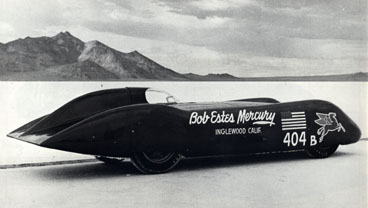
The Hill-Davis streamliner was back at Speed Week in 1953, still as the "Bob Estes Mercury Special", although now painted dark blue metallic, with Otto Ryssman at the wheel, since Hill had an engagement to drive another car. Ryssman did qualify in class B at 231.80 mph, just over the record the car already held, but the engine refused to run properly during the actual attempt. The car was still the second fastest after the twin-engined Kenz & Leslie streamliner.
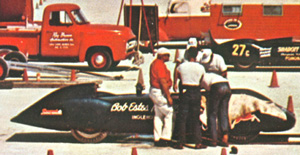
George Hill did not have any luck either when he drove the car again in the AAA Speed Trials. The team had rushed to get a new engine ready to replace the one damaged during the SCTA Speed Week, but after a run at 237, on the return run suddenly the cockpit was fgilled with smoke and Hill had to cpast off the course as he could not breath any more. Eventually he even lost his two International records to Mal Hooper's Shadoff Spl., the rear-engined "sister car" that Dean Batchelor had designed on the same lines of the Hill-Davis car.
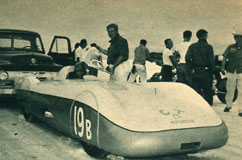
In 1954 Hill and Davis were back with the streamliner, now painted white and blue: they qualified again, at 236.53 in Class B, but again they ran out of luck and blew the usual C-T Mercury in the record attempt. Things did not get any better after switching to a Dodge V8.
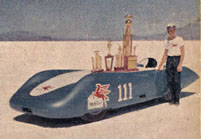
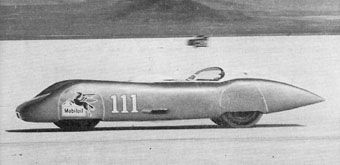
Thus ended the four-year career of a car that was a true milestone in the history of land speed racing. I am sure the driver was most grateful that the two young, relatively unexperienced hot rodders who had built it had payed so much attention to safety as to fit a real solid rollbar to it in times when rollbars where not even mentioned in the rules!
© Ugo Fadini 2003/2005
(Source: contemporary magazines)
Note 1: contemporary photos for 1952 show the car with two different windshield/cockpit arrangements: either a conventional curved windshield that leaved the head of the driver exposed, or a streamlined "bubble top", as featured on my model. I found no explanation or even reference to this in any contemporary reports or later stories and both the two layouts appear at both the SCTA speed week and at the AAA speed trials, so I have to assume that they coexisted and the simpler, open layout was probably usued for test runs, while the streamlined "bubble top", which imposed a less comfortable driving position, but substantially improved streamlining, was most likely used for the actual attempts (in addition to official photo sessions). In later years the car always appears with the streamlined "bubble top" only.
Note 2: a detailed account of the building of the Hill-Davis streamliner has been published on Bonneville Racing News magazine, issues from June to September 1996, written by Geoffrey Harding, with notes by George Hill on driving the car (both can now be read on the www.bonneville2012.com website, under "History" and "Other stuff").
| venue | year | driver | sanctioning body | class | distance | speed (mph) |
|---|---|---|---|---|---|---|
| Bonneville SCTA Speed Trials | Aug 1952 | George Hill | SCTA | B/S | fl. mile | 230.16 |
| Bonneville AAA Speed Trials | Sep 1952 | George Hill | FIA | Intl. A, I, C | fl. km | 226.898 |
| Bonneville AAA Speed Trials | Sep 1952 | George Hill | FIA | Intl. A, I, C | fl. mile | 229.774 |
| Bonneville AAA Speed Trials | Sep 1952 | George Hill | AAA | Natl., C | st. km | 85.485 |
| Bonneville AAA Speed Trials | Sep 1952 | George Hill | AAA | Natl., C | st. mile | 104.01 |
| Bonneville SCTA Speed Trials | Aug 1955 | George Hill | SCTA | B/S | fl. mile | 236.842 |
(January 2010) - Dave Thomas and Bill "Willie" Davis are building a replica of the original City of Burbank streamliner that will be entered in the the 2012 SCTA Speed Week next August.
Read all the details and follow the build up on the www.bonneville2012.com website.



Go to the Hill-Davis model page |
|---|
Back to land speed record topics index |
|---|
____________________________________________________________________________________________________________
Home | About Ugo Fadini | Current models | How to order | Discontinued models | Models to come | Articles & Stories | Links
© Ugo Fadini 2000/2012 - page last updated 20 January 2012